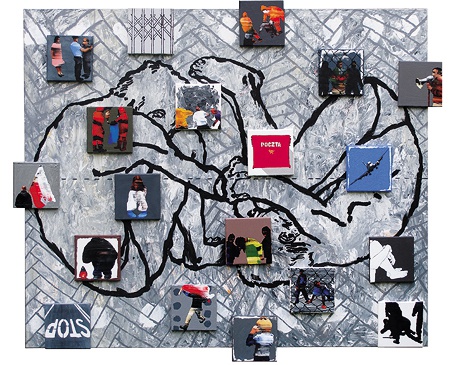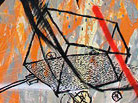Ireneusz Walczak paintings' — Constructing identity

Ireneusz Walczak (born in 1961) is a graduate from the faculty of printmaking of the Academy of Fine Arts in Cracow (Katowice branch). Since 1988 he has worked at Katowice branch of the Academy, being its adjunct at present.
Walczak’s rich artistic output includes numerous solo and group exhibitions, for example in Leipzig, Frankfurt, Glasgow, Amsterdam, Berlin, and Stockholm, as well as scholarships and awards: Grand Prix of the Work of the Year contest, organised by the Union of Polish Artists and Designers in Katowice (1992, 2001, 2003), Grand Prix of the all-Poland Towards Values contest (1988), Grand Prix of the 1st World Small Print Forms Triennial (France, 1988), Grand Prix of the Rafał Pomorski Painting Contest, and Jackson Pollock Scholarship (USA, 1993).

Ireneusz Walczak paintings' — Constructing identity Various alter ego are functioning beside each other Walczak’s creation brings in mind Heidegger’s ‘Being and Time’ and ‘Being-in-the-World’. In the works...

A human figure seen from its back, often limited only to its fragment, is the characteristic motive of works by Ireneusz Walczak. Echoes of expressionism, American painting after 1945 or Francis Bacon’s painting have been present in his artistic language since the very beginning. A good example of Walczak’s formal attitude can be seen in his cycle ‘Walls of the Past’ of the years 1998-2002, where he uses such means of expression as decisive ‘pure’ colours, strong and clear line of drawings, and differentiated texture.
Calmed aggressive solutions in his pictures include the domination of subdued colours which mostly belong to the cool fragment of the colour range. His pictures create metaphysical mood, a bit melancholic, and are an analysis of the current situation of an individual as seen from the point of view of past events which build the ‘walls’ of divisions and solitude. The cycle ‘Present/Absent’ of the years 2002-2003 brings up the question of man’s looking for his own place in the world and interpersonal communication.
‘Building an Identity’ is a narration about man: the individual stories, composed on the surface of his pictures, speak about human condition. His painting compositions present a man immersed in the surrounding reality and specifying himself in contact with the world. Loneliness in the crowd can be seen from behind internal landscapes and comic strip ‘reportages’ on everyday life; this is suggested by divided quarters, where people are ‘separate’. With his specific means of expression, the artist emphasizes the processual character of existence of an individual — the state of continuous change and construction of ‘I’, resulting from his choices. Hieroglyphic tales are often a framework for the central part of a composition with a human figure. The figure is as if projected on a ‘screen’, including its interior and factorised experiences. The frames of individual moments of existence arrange a kaleidoscopic image. Central figure can be multiplied. The operation associates with mirror reflection, with Alice on the other side of the mirror or n mirrors, with an ‘imprint’ of the former ‘I’ from before the transformation. Various alter ego are functioning beside each other Walczak’s creation brings in mind Heidegger’s ‘Being and Time’ and ‘Being-in-the-World’. In the works presented at the exhibition, the artist asks about identity. There’s no unequivocal answer to this question. Everyone is responsible for his own identity, for his choices and for building the sense of life.
Problems of identity imply the fundamental questions of existence, including decision taking, time, and memory, which indicate at continuous process of self-creation, and continuous reinterpretation of our own ‘I’ under the influence of occurring circumstances. Ireneusz Walczak’s painting is a kind of psychoanalysis of contemporary man. The presence of the body image in the artist’s creation in times of digitalisation which seems to invalidate it, makes us remember that it’s inscribed in human identity.
A human figure seen from its back, often limited only to its fragment, is the characteristic motive of works by Ireneusz Walczak. Echoes of expressionism, American painting after 1945 or Francis Bacon’s painting have been present in his artistic language since the very beginning. A good example of Walczak’s formal attitude can be seen in his cycle ‘Walls of the Past’ of the years 1998-2002, where he uses such means of expression as decisive ‘pure’ colours, strong and clear line of drawings, and differentiated texture.
Calmed aggressive solutions in his pictures include the domination of subdued colours which mostly belong to the cool fragment of the colour range. His pictures create metaphysical mood, a bit melancholic, and are an analysis of the current situation of an individual as seen from the point of view of past events which build the ‘walls’ of divisions and solitude. The cycle ‘Present/Absent’ of the years 2002-2003 brings up the question of man’s looking for his own place in the world and interpersonal communication.
‘Building an Identity’ is a narration about man: the individual stories, composed on the surface of his pictures, speak about human condition. His painting compositions present a man immersed in the surrounding reality and specifying himself in contact with the world. Loneliness in the crowd can be seen from behind internal landscapes and comic strip ‘reportages’ on everyday life; this is suggested by divided quarters, where people are ‘separate’. With his specific means of expression, the artist emphasizes the processual character of existence of an individual – the state of continuous change and construction of ‘I’, resulting from his choices. Hieroglyphic tales are often a framework for the central part of a composition with a human figure. The figure is as if projected on a ‘screen’, including its interior and factorised experiences. The frames of individual moments of existence arrange a kaleidoscopic image. Central figure can be multiplied. The operation associates with mirror reflection, with Alice on the other side of the mirror or n mirrors, with an ‘imprint’ of the former ‘I’ from before the transformation. Various alter ego are functioning beside each other Walczak’s creation brings in mind Heidegger’s ‘Being and Time’ and ‘Being-in-the-World’. In the works presented at the exhibition, the artist asks about identity. There’s no unequivocal answer to this question. Everyone is responsible for his own identity, for his choices and for building the sense of life.
Problems of identity imply the fundamental questions of existence, including decision taking, time, and memory, which indicate at continuous process of self-creation, and continuous reinterpretation of our own ‘I’ under the influence of occurring circumstances. Ireneusz Walczak’s painting is a kind of psychoanalysis of contemporary man. The presence of the body image in the artist’s creation in times of digitalisation which seems to invalidate it, makes us remember that it’s inscribed in human identity.
Ireneusz Walczak (born in 1961) is a graduate from the faculty of printmaking of the Academy of Fine Arts in Cracow (Katowice branch). Since 1988 he has worked at Katowice branch of the Academy, being its adjunct at present.
Walczak’s rich artistic output includes numerous solo and group exhibitions, for example in Leipzig, Frankfurt, Glasgow, Amsterdam, Berlin, and Stockholm, as well as scholarships and awards: Grand Prix of the Work of the Year contest, organised by the Union of Polish Artists and Designers in Katowice (1992, 2001, 2003), Grand Prix of the all-Poland Towards Values contest (1988), Grand Prix of the 1st World Small Print Forms Triennial (France, 1988), Grand Prix of the Rafał Pomorski Painting Contest, and Jackson Pollock Scholarship (USA, 1993).




